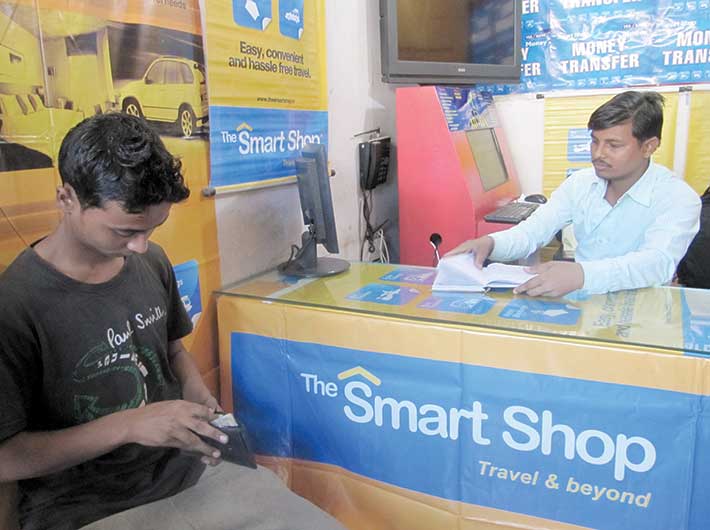India’s youngest bank, Yes Bank, has developed a model financial inclusion that is winning it not only awards but a whole lot of cash: over Rs 900 crore in 15 months!
In a pocket-sized outlet running along tony shops in Oshiwara-Behrampada area of Andheri West—one of Mumbai’s busiest suburbs—Alam, a young labourer from Uttar Pradesh, has come to send Rs 1,500 home to his mother’s savings account in Bank of Baroda, back in Dostpur twn of Sultanpur district.
He hands over the money to Harish Chand Tiwari, a travel and money transfer agent, who jots down Alam’s mobile number and feeds details of the beneficiary account into the system. If the details are correct—as they are in this case— a verification code (OTP) is sent instantly by Yes Bank for confirmation on the agent’s mobile. Tiwari feeds that into the system and, voila!, the money is transferred into Alam’s mother’a account. Instantly.
Alam pays Rs 25 as registration charge and Rs 23 as transaction cost—shared by the business correspondent (BC, Tiwari in this case) and the service provider (Yes Bank).
Manoj Kumar, 29, a mechanic arrives after Alam. He wants to transfer Rs 1,000 to a savings account in Punjab National Bank’s branch at Ratni, Bihar. Since his number is already registered with Yes Money services, he only pays the transaction cost: at 1.5 percent of the amount remitted, it comes to Rs 15. His work is done in five minutes.
Since its launch nearly 15 months ago, Yes Bank’s “domestic remittance services for migrant labourers” has about 12,000 business correspondent agents/outlets and has clocked 2.1 million transactions with 4.9 lakh customers across 186 cities. The service has sent money to 16,438 branches of various banks across India, says Anand Kumar Bajaj, chief innovation officer of Yes Bank and head of the project.
Among Yes Bank’s 11 BC partners at present are the likes of Suvidha, Oxygen, Itz Cash, Eco, Easy Bill, Pay Point, Pay World and Multilink. Nine more are in the pipeline, Bajaj says.
So how did the idea come about? Over to Bajaj: “Driving to office early mornings, we saw long queues outside the State Bank of India, Punjab National Bank and Union Bank every day, and we wondered why young men stood in long lines, like pensioners. We soon learnt they were migrant workers waiting to send money back home. These men neither have accounts nor KYC documents (‘know your customer’, required by banks for all transactions) in urban centres. So, to send money anywhere through banks, they have to wait in long queues at limited counters outside limited bank branches during specific hours of the day. “That is because all counters do not serve these migrant workers.”
The opportunity identified, it was time to put the heads together—or “scratch our heads”, as Bajaj puts it—to find a solution. Combining the national electronic funds transfer (NEFT) technology and business correspondent guidelines (commonly perceived to be applicable only in rural areas, as banks want a BC in every 30-km radius), Bajaj and his team decided to adopt lessons from the telecom sector and apply them in an urban milieu. “We found that telecoms had cut the queues at PCOs mainly by bringing in mobile phones, micro-transactions and self-loading, among others. Self-loading is not done entirely by the end-customer; it is rendered through assisted service. So if a telephone top-up meant to be online is rendered in an assisted service mode, (we figured out) our online banking service could also be rendered by the same set of people in an assisted mode,” Bajaj says.
Solution identified, game on
While NEFT works on an hourly cycle that works till 7-8 pm on weekdays, half-day on Saturdays, and does not work on Sundays, another mode Yes Bank adopted is a scheme by the National Payment Corporation of India (NPCI), called the interbank mobile payment switch (IMPS). This, Bajaj explains, is a method of payment that transmits money in four seconds flat. The customer’s bank account is mapped to IMPS at the backend, and he/she gets money within four seconds. The system works 24x7 and adds speed to remittance.
So how does it work? Bajaj explains that a customer will type in details like his/her mobile number, the mobile money identifier (MMID) and the amount of transfer in his/her cellphone and instructs the bank, which checks if the person is an authorized user and has sufficient balance in his/her account. The bank thereafter passes the information to NPCI, which switches it to the other bank to pass credit to the beneficiary account. The customer’s own bank immediately sends an SMS alert about the credit.
“With this we became the rockstars at NPCI, clocking 70 percent of its total volumes. All other banks do the remaining 30 percent volumes,” says Bajaj, beaming with pride. He says the anytime-remittance in four seconds has helped customers do their transaction at their own time and pace. To illustrate, he says 48 percent to 52 percent of Yes Bank’s transactions take place beyond the banking hours—between 4 pm and 11.55 pm and from 6 am to 10 am.
“This has changed the entire ecosystem in money remittance. The customer in the last mile gets money in four seconds, which earlier only SBI, PNB or Axis Bank did that too only for customers depositing money in their own accounts of the same bank.”
Bajaj says his BC agents could be anyone—owners or employees of mom-and-pop stores, milk booths, medical stores that open early and work till late.
“In March last year RBI issued a guideline for interoperability of BCs—that is, a bank, through it BCs, should be able to service customers of multiple banks. Only we are doing this—we service customers of multiple banks. We are a few steps ahead of what the RBI is asking compliance for, and are looking at more engaging partnerships for further reach,” says Bajaj.
As for the revenue model, Bajaj, a chartered accountant by qualification, explains that by default, settlements through NPCI are delayed by a day and therefore generate good revenue for Yes Bank due to float income. The beneficiary, though, receives the money in four seconds. The other part of its revenue, the 1.5 percent fee it charges customers for transmission, is lower than the post office charge of 5 percent and telecom operators’ 2-3 percent. “With this, we proved that the remittance business is not hand to mouth,” Bajaj says.
Within four months of its launch, Yes Bank’s domestic remittance services project was ‘sanitised’—through an RBI circular allowing other banks to offer the same. “This was a certificate for the bank,” Bajaj says with justifiable pride. He gives the credit for this success to the small structure of his team, the interconnect between financial inclusion, cash management, corporate net banking and technology teams, and the bank’s BC partners. Stressing that this team “connected the dots,” Bajaj says, “What we cracked as a whole is now available to the masses and every bank can offer this. Though it is now competition to us, I feel redeemed.”
Applying the business model and renditions of telecom sector, Yes Bank in the role of aggregator uses infrastructure of its competitors to send money to them. So if some other banks have branches in rural areas, Yes Bank Services will send money there, Bajaj says. “It’s like call origination and termination in telecommunication—we will originate remittances with Yes Bank, and terminate with them (the other banks).”
An interesting fact that emerged from analysing the pattern of remittances was that in 9 percent cases, customers were not travelling to their bank branches within the city for cash deposits but were using Yes Money Services, Bajaj says.
Bajaj is elated yet down to earth while acknowledging the success of the project —one that was earlier rejected 18 or 19 times but has now 11 awards in its kitty, the latest being Nasscom’s Social Innovation Honours for saving five hours each of 2 million transactions, or adding nearly 1 crore hours to the economy. Bajaj says, “As an innovation in charge, you are only a catalyst. We created the project out of curiosity (but) Yes Money has now become a brand, a commodity, on its own.”
On March 1, he will receive the ‘financial insight innovation award’ in Singapore, and this project, according to Bajaj, is nothing if not about innovation. Nasscom had earlier honoured the project with the ‘best IT user award’.
While India’s remittance market is Rs 1,50,000 crore, Yes Money Services has clocked Rs 901 crore since it started 15 months ago. The targets for the coming years, Bajaj says, is to have 2 lakh visible points in the country and cover all 85,000 branches of various banks across the country and to take on Rs 10,000 crore remittance.
(This story appeared in the March 1-15 print issue of the magazine)

